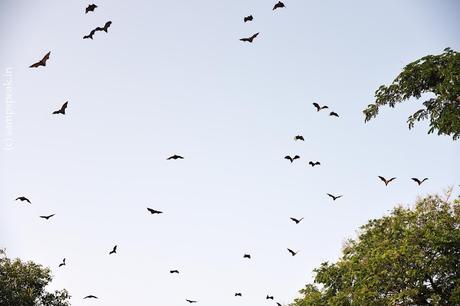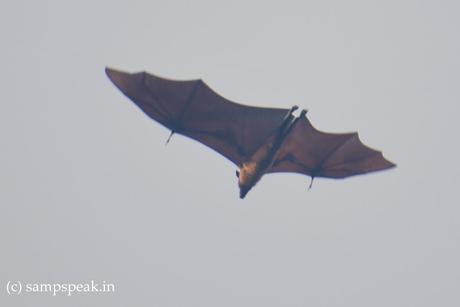Do you know what this is ??

Decades ago, we saw famous batsmen using and endorsing bats like Slazenger, G&M, Grey Nicholls, SG, SS, BDM and the like….. now you see bats without brand name explicit but advertiser’s logo prominent !! (in between those days there were ‘oiled /non-oiled bats’) ~ for a change this is no post on Cricket but on bats !!
We have seen them on some old temples, I have seen them at Thavana uthsava bungalow gori !! - the Egmore Museum does not just house priceless artefacts from the past. It also houses colonies of fruit bats in the trees outside, as a plaque informed the visitors those days. A few months ago, I saw them arrive with a buzz around 615 – 630 pm – close to hundred – flying with unerring precision from nowhere and hanging on the Arasa maram [peepal tree] at Vasavi Parthas, Venkatrangam Street, Triplicane, Chennai 600005.
When we think of bats, an unfavorable image often comes to mind. Whether it's the scary portrayal of them in vampire films and literature or a general fear of how their real-life counterparts might transmit viruses, bats have gotten a bad rap that's actually more fiction than fact. Understand that there are more than 1,400 bat species in the world ! Bats can be as large as a small dog or as small as a bee. The ones that come nearer home resemble crows !! The largest bats are the flying foxes with wingspans of up to 2 metres and a body weights of up to 1.5 kilograms.

Bats are mammals of the order Chiroptera. With their forelimbs adapted as wings, they are the only mammals capable of true and sustained flight. Bats are more manoeuvrable than birds, flying with their very long spread-out digits covered with a thin membrane or patagium. The second largest order of mammals after rodents, bats comprise about 20% of all classified mammal species worldwide. For centuries, bats have been called sinister and spooky, likely because of their beady eyes and razor-sharp fangs. But there’s more to these nocturnal creatures than meets the eyes. The scientific name for bats Chiroptera, is Greek for “hand wing.” That’s because bats have four long fingers and a thumb, each connected to the next by a thin layer of skin. To navigate dark caves and hunt after dark, microbats rely on echolocation, a system that allows them to locate objects using sound waves. They echolocate by making a high-pitched sound that travels until it hits an object and bounces back to them. This echo tells them an object’s size and how far away it is.
The age-old question of upside down bats. Yes, it is awfully weird that there is an animal—a mammal even—that hangs upside down. Sure, some monkeys do it when they're just monkeying around. Bats are the only animals that actually spend most of their time hanging upside down: feeding this way, raising their young this way, and, yes, sleeping or roosting this way. Bats are not birds, nor are they insects. The difference between bat flight and bird or insect flight is weight—specifically, the ratio of weight to lift-capacity of the wings. Birds have hollow bones; bats don’t. To compensate for the extra weight that mammals must have, to compensate for the problem of getting off the ground, evolution found another way for bats to transition from being motionless to immediately being able to fly when necessary.

Though they are reportedly harmless, they are scary and in the twilight – crows do appear agitated, when these bats start homing in to the peepal tree.
Recently read this article in TOI - some regular visitors to Tower Park at Anna Nagar have been bursting firecrackers every day for the past week to drive away bats that roost in the trees there. After animal rights activists complained, civic officials said they would prevent this. “We have received many petitions over the past two years from residents in the area to relocate the bats. These people claimed that the noise from the bats and their fecal droppings disturbed walkers in the park. We have asked the forest department for its opinion,” said, regional deputy commissioner Sharanya Ari. She said the civic body had decided to put up a sheet in the walking area to protect walkers from bat droppings.
One of the walkers at the park, Vasantha, who shot the video of people bursting firecrackers and informed the police, “The park is meant for the bats too. They are not really harming anyone. By chasing them away from their natural habitat, these misinformed men are actually driving the bats to seek other shelters closer to homes.” Sanjay Molur, executive director of Zoo Outreach, said bats rarely disturb humans during the day as they sleep most of the time. Droppings happen early in the morning or late in the evening. “But the idea of the sheet is a good one,” he said. “These fruit bats found in the cities have a major role in afforestation. The germination chances after a seed goes through a bat gut is 90% higher than birds. “Bat droppings are rich in nitrogen and a good fertilizer,” said Molur, who has done his PhD on bats. He also said don’t make much noise unless disturbed.
There are at least 25 species of bats in the city and suburbs. “This is an exaggerated response. Bats don’t directly infect humans. There will always be an intermediary host such as palm sap for Nipah virus, pigs and other mammals,” he said.
The game of cricket has evolved a lot over the years. Rules and format have been changed, equipment too have become part of an inevitable evolutionary process. Most of these changes have favoured the batsmen. They have benefitted from the shorter boundaries, flatter tracks and thicker bats. .. .. Cricket bats perhaps have not changed much .. .. yesterday during the break in the Test between England and India, there was a feature on ‘evolution of bats’.
It has become a common theme now – we have seen this in recent times, edges flying over the slip cordon or over the wicketkeeper and thirdman or fineleg for a 6. It is the heavy bats ! - The bat consists of two parts, a handle and a blade.
The history of the cricket bat is a fascinating, intriguing tale of the very evolution of the game itself, from the hockey stick-like beginnings to the brutal, beautifully-crafted profiles of modern day. Though it remains the batsman’s key instrument of expression and destruction its shape, weight, power and quality of materials have changed through cricketing history. Cambridge University suggested one such modification when they asked the Marylebone Cricket Club (MCC) to change the material used in making cricket bats from willow to bamboo.
According to research at the Centre for Natural Material Innovation, bamboo bats would be lighter, stronger and offer a larger ‘sweet spot’- the point from which the ball takes the maximum acceleration. “Currently, law 5.3.2 states that the blade of the bat must consist solely of wood, so for bamboo (which is a grass) to be considered as a realistic alternative to willow would require a law change,” MCC stated. The overall length of the bat, when the lower portion of the handle is inserted, shall not be more than 38 in/96.52 cm. According to rule : 5.7.2 The blade of the bat shall not exceed the following dimensions:
Width: 4.25in / 10.8 cm; Depth: 2.64in / 6.7 cm; Edges: 1.56in / 4.0cm.
Furthermore, it should also be able to pass through a bat gauge – the photo of which appeared at the start of this post !
With regards – S. Sampathkumar8th Aug 2021.

